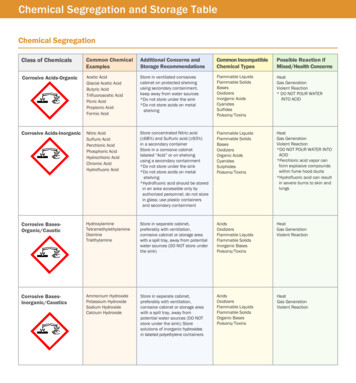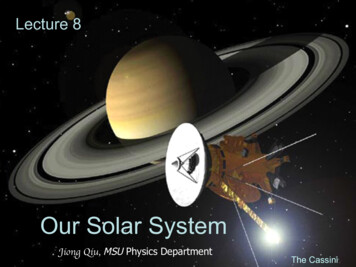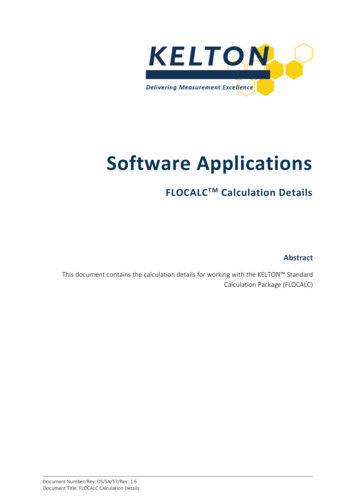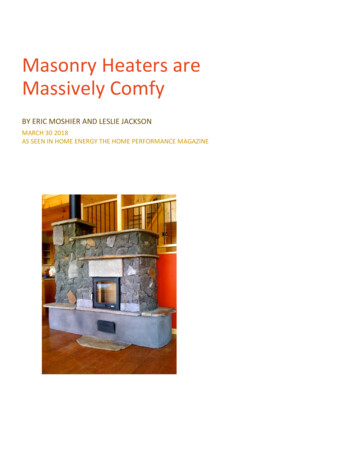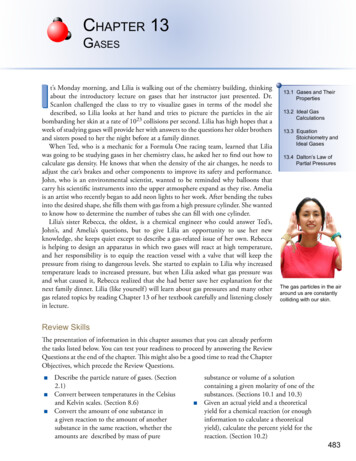
Transcription
Chapter 13Gasest’s Monday morning, and Lilia is walking out of the chemistry building, thinkingabout the introductory lecture on gases that her instructor just presented. Dr.Scanlon challenged the class to try to visualize gases in terms of the model shedescribed, so Lilia looks at her hand and tries to picture the particles in the airbombarding her skin at a rate of 1023 collisions per second. Lilia has high hopes that aweek of studying gases will provide her with answers to the questions her older brothersand sisters posed to her the night before at a family dinner.When Ted, who is a mechanic for a Formula One racing team, learned that Liliawas going to be studying gases in her chemistry class, he asked her to find out how tocalculate gas density. He knows that when the density of the air changes, he needs toadjust the car’s brakes and other components to improve its safety and performance.John, who is an environmental scientist, wanted to be reminded why balloons thatcarry his scientific instruments into the upper atmosphere expand as they rise. Ameliais an artist who recently began to add neon lights to her work. After bending the tubesinto the desired shape, she fills them with gas from a high pressure cylinder. She wantedto know how to determine the number of tubes she can fill with one cylinder.Lilia’s sister Rebecca, the oldest, is a chemical engineer who could answer Ted’s,John’s, and Amelia’s questions, but to give Lilia an opportunity to use her newknowledge, she keeps quiet except to describe a gas-related issue of her own. Rebeccais helping to design an apparatus in which two gases will react at high temperature,and her responsibility is to equip the reaction vessel with a valve that will keep thepressure from rising to dangerous levels. She started to explain to Lilia why increasedtemperature leads to increased pressure, but when Lilia asked what gas pressure wasand what caused it, Rebecca realized that she had better save her explanation for thenext family dinner. Lilia (like yourself ) will learn about gas pressures and many othergas related topics by reading Chapter 13 of her textbook carefully and listening closelyin lecture.13.1 Gases and TheirProperties13.2 Ideal GasCalculations13.3 EquationStoichiometry andIdeal Gases13.4 Dalton’s Law ofPartial PressuresThe gas particles in the airaround us are constantlycolliding with our skin.Review SkillsThe presentation of information in this chapter assumes that you can already performthe tasks listed below. You can test your readiness to proceed by answering the ReviewQuestions at the end of the chapter. This might also be a good time to read the ChapterObjectives, which precede the Review Questions.Describe the particle nature of gases. (Section2.1)Convert between temperatures in the Celsiusand Kelvin scales. (Section 8.6)Convert the amount of one substance ina given reaction to the amount of anothersubstance in the same reaction, whether theamounts are described by mass of puresubstance or volume of a solutioncontaining a given molarity of one of thesubstances. (Sections 10.1 and 10.3)Given an actual yield and a theoreticalyield for a chemical reaction (or enoughinformation to calculate a theoreticalyield), calculate the percent yield for thereaction. (Section 10.2)483
484Chapter 13Gases13.1 Gases and Their PropertiesObjective 2Objective 3Figure 13.1Particles of a GasIf you want to understand how gases behave—such as why fresh air rushes into yourlungs when certain chest muscles contract or how gases in a car’s engine move thepistons and power the car—you need a clear mental image of the model chemistsuse to explain the properties of gases and the relationships between them. The modelwas introduced in Section 2.1, but we’ll be adding some new components to it in thereview presented here.Gases consist of tiny particles widely spaced (Figure 13.1). Under typical conditions,the average distance between gas particles is about ten times their diameter. Becauseof these large distances, the volume occupied by the particles themselves is very smallcompared to the volume of the empty space around them. For a gas at room temperatureand pressure, the gas particles themselves occupy about 0.1% of the total volume. Theother 99.9% of the total volume is empty space (whereas in liquids and solids, about70% of the volume is occupied by particles). Because of the large distances between gasparticles, the attractions or repulsions among them are weak.The particles in a gas are in rapid and continuous motion. For example, the averagevelocity of nitrogen molecules, N2, at 20 C is about 500 m/s. As the temperatureof a gas increases, the particles’ velocity increases. The average velocity of nitrogenmolecules at 100 C is about 575 m/s.The particles in a gas are constantly colliding with the walls of the container andwith each other. Because of these collisions, the gas particles are constantly changingtheir direction of motion and their velocity. In a typical situation, a gas particle movesa very short distance between collisions. For example, oxygen, O2, molecules at normaltemperatures and pressures move an average of 10-7 m between collisions.
13.1 Gases and Their PropertiesIdeal GasesThe model described above applies to real gases, but chemists often simplify the modelfurther by imagining the behavior of an ideal gas. An ideal gas differs from a real gasin thatThe particles are assumed to be point masses, that is, particles that have amass but occupy no volume.There are no attractive or repulsive forces at all between the particles.When we add these assumptions to our model for gases, we call it the ideal gas model.As the name implies, the ideal gas model describes an “ideal” of gas behavior thatis only approximated by reality. Nevertheless, the model succeeds in explaining andpredicting the behavior of typical gases under typical conditions. In fact, some actualgases do behave very much in accordance with the model, and scientists may callthem ideal gases. The ideal gas assumptions make it easier for chemists to describe therelationships between the properties of gases and allow us to calculate values for theseproperties.Objective 4Properties of GasesThe ideal gas model is used to predict changes in four related gas properties: volume,number of particles, temperature, and pressure. Volumes of gases are usually describedin liters, L, or cubic meters, m3, and numbers of particles are usually described inmoles, mol. Although gas temperatures are often measured with thermometers thatreport temperatures in degrees Celsius, C, scientists generally use Kelvin temperaturesfor calculations. Remember that you can convert between degrees Celsius, C, andkelvins, K, using the following equations.? K C 273.15? C K - 273.15To understand gas pressure, picture a typical gas in a closed container. Each time agas particle collides with and ricochets off one of the walls of its container, it exerts aforce against the wall. The sum of the forces of these ongoing collisions of gas particlesagainst all the container’s interior walls creates a continuous pressure upon those walls.Pressure is force divided by area.The accepted SI unit for gas pressure is the pascal, Pa. A pascal is a very small amount ofpressure, so the kilopascal, kPa, is more commonly used. Other units used to describegas pressure are the atmosphere (atm), torr, millimeter of mercury (mmHg), and bar.The relationships between these pressure units are1 atm 101,325 Pa 101.325 kPa 760 mmHg 760 torr1 bar 100 kPa 0.9869 atm 750.1 mmHgThe numbers in these relationships come from definitions, so they are all exact. At sealevel on a typical day, the atmospheric pressure is about 101 kPa, or about 1 atm.In calculations, the variables P, T, V, and n are commonly used to represent pressure,temperature, volume, and moles of gas.Objective 5Objective 6Objective 7Objective 8Objective 9485
486Chapter 13GasesDiscovering the Relationships Between PropertiesIf we want to explain why a weather balloon carrying instruments into the upperatmosphere expands as it rises, we need to consider changes in the properties of thegases (pressure, volume, temperature, or number of gas particles) inside and outsidethe balloon. For example, as the balloon rises, the pressure outside of it, called theatmospheric pressure, decreases. But, there are also variations in temperature, and theballoon might have small leaks that change the number of gas particles it contains.In a real situation, pressure, temperature, and number of gas particles may all bechanging, and predicting the effect of such a blend of changing properties on gasvolume is tricky. Therefore, before we tackle predictions for real world situations, suchas the weather balloon, we will consider simpler systems in which two of the four gasproperties are held constant, a third property is varied, and the effect of this variation onthe fourth property is observed. For example, it is easier to understand the relationshipbetween volume and pressure if the number of gas particles and temperature are heldconstant. The volume can be varied, and the effect this has on the pressure can bemeasured. An understanding of the relationships between gas properties in controlledsituations will help us to explain and predict the effects of changing gas properties inmore complicated, real situations.Figure 13.2 shows a laboratory apparatus that can be used to demonstrate all therelationships we are going to be discussing. It consists of a cylinder with a movablepiston, a thermometer, a pressure gauge, and a valve through which gas may be addedto the cylinder’s chamber or removed from it.Figure 13.2Apparatus Used to Demonstrate RelationshipsBetween the Properties of GasesThe Relationship Between Volume and PressureObjective 10aObjective 10aFigure 13.3 shows how our demonstration apparatus would be used to determinethe relationship between gas volume and pressure. While holding the number of gasparticles constant (by closing the valve) and holding the temperature constant (byallowing heat to transfer in or out so that the apparatus remains the same temperatureas the surrounding environment), we move the piston to change the volume, and thenwe observe the change in pressure. When we decrease the gas volume, the pressuregauge on our system shows us that the gas pressure increases. When we increase the gasvolume, the gauge shows that the pressure goes down.Decreased volume Increased pressureIncreased volume Decreased pressure
13.1 Gases and Their Properties487For an ideal gas (in which the particles occupy no volume and experience no attractionsor repulsions), gas pressure and volume are inversely proportional. This means thatif the temperature and the number of gas particles are constant and if the volumeis decreased to one-half its original value, the pressure of the gas will double. If thevolume is doubled, the pressure decreases to one-half its original value. The followingexpression summarizes this inverse relationship:Objective 10aReal gases deviate somewhat from this mathematical relationship, but the general trendof increased pressure with decreased volume (or decreased pressure with increasedvolume) is true for any gas.The observation that the pressure of an ideal gas is inversely proportional to the volumeit occupies if the number of gas particles and the temperature are constant is a statementof Boyle’s Law. This relationship can be explained in the following way. When thevolume of the chamber decreases but the number of gas particles remains constant,there is an increase in the concentration (number of particles per liter) of the gas. Thisleads to an increase in the number of particles near any given area of the container wallsat any time and to an increase in the number of collisions against the walls per unit areain a given time. More collisions mean an increase in the force per unit area, or pressure,of the gas. The logic sequence presented in Figure 13.3 summarizes this explanation.The arrows in the logic sequence can be read as “leads to.” Take the time to read thesequence carefully to confirm that each phrase leads logically to the next.Figure 13.3Relationship Between Volumeand PressureDecreased volume leadsto increased pressure if thenumber of gas particles and thetemperature are constant.Objective 10aYou can see ananimation thatdemonstratesthis relationshipat the textbook’sWeb site.
488Chapter 13GasesThe Relationship Between Pressure and TemperatureObjective 10bObjective 10bObjective 10bFigure 13.4In order to examine the relationship between pressure and temperature, we must adjustour demonstration apparatus so that the other two properties (number of gas particlesand volume) are held constant. This can be done by locking the piston so it cannotmove and closing the valve tightly so that no gas leaks in or out (Figure 13.4). Whenthe temperature of a gas trapped inside the chamber is increased, the measured pressureincreases. When the temperature is decreased, the pressure decreases.Increased temperature Increased pressureDecreased temperature Decreased pressureWe can explain the relationship between temperature and pressure using our modelfor gas. Increased temperature means increased motion of the particles. If the particlesare moving faster in the container, they will collide with the walls more often and withgreater force per collision. This leads to a greater overall force pushing on the walls andto a greater force per unit area or pressure (Figure 13.4).If the gas is behaving like an ideal gas, a doubling of the Kelvin temperature doublesthe pressure. If the temperature decreases to 50% of the original Kelvin temperature,the pressure decreases to 50% of the original pressure. This relationship can be expressedby saying that the pressure of an ideal gas is directly proportional to the Kelvin temperatureof the gas if the volume and the number of gas particles are constant. This relationship issometimes called Gay-Lussac’s Law.P T if n and V are constantRelationship BetweenTemperature and PressureIncreased temperature leadsto increased pressure if thenumber of gas particles andvolume are constant.Objective 10bYou can see ananimation thatdemonstratesthis relationshipat the textbook’sWeb site.
13.1 Gases and Their Properties489The Relationship Between Volume and TemperatureConsider the system shown in Figure 13.5. To demonstrate the relationship betweentemperature and volume of gas, we keep the number of gas particles and gas pressureconstant. If our valve is closed and if our system has no leaks, the number of particlesis constant. We keep the gas pressure constant by allowing the piston to move freelythroughout our experiment, because then it will adjust to keep the pressure pushingon it from the inside equal to the constant external pressure pushing on it due to theweight of the piston and the atmospheric pressure. The atmospheric pressure is thepressure in the air outside the container, which acts on the top of the piston due to theforce of collisions between particles in the air and the top of the piston.If we increase the temperature, the piston in our apparatus moves up, increasing thevolume occupied by the gas. A decrease in temperature leads to a decrease in volume.Increased temperature Increased volumeDecreased temperature Decreased volumeThe increase in temperature of the gas leads to an increase in the average velocity ofthe gas particles, which leads in turn to more collisions with the walls of the containerand a greater force per collision. This greater force acting on the walls of the containerleads to an initial increase in the gas pressure. Thus the increased temperature of ourgas creates an internal pressure, acting on the bottom of the piston, that is greaterthan the external pressure. The greater internal pressure causes the piston to move up,increasing the volume of the chamber. The increased volume leads to a decrease in gaspressure in the container, until the internal pressure is once again equal to the constantexternal pressure (Figure 13.5). Similar reasoning can be used to explain why decreasedtemperature leads to decreased volume when the number of gas particles and pressureare held constant.For an ideal gas, volume and temperature described in kelvins are directly proportionalif the number of gas particles and pressure are constant. This is called Charles’ Law.V T if n and P are constantObjective 10cPlacing a balloon inliquid nitrogen lowersthe temperature ofthe gas and causesan initial decrease inpressure. With its internalpressure now lowerthan the pressure of theair outside, the balloonshrinks to a much smallervolume.The University of MichiganDepartment of Physics LectureDemonstration LabFigure 13.5Relationship Between Temperature andVolume Increased temperature leads toincreased volume if the number of gasparticles and pressure are constant.Objective 10cYou can see an animation thatdemonstrates this relationship atthe textbook’s Web site.
490Chapter 13GasesThe Relationship Between Number of Gas Particles and PressureObjective 10dObjective 10dTo explore the relationship between gas pressure and the number of gas particles, wecould set up our experimental system as shown in Figure 13.6. The volume is heldconstant by locking the piston so it cannot move. The temperature is kept constant byallowing heat to flow in or out of the cylinder in order to keep the temperature of thegas in the cylinder equal to the external temperature. When the number of gas particlesis increased by adding gas through the valve on the left of the cylinder, the pressuregauge shows an increase in pressure. When gas is allowed to escape from the valve, thedecrease in the number of gas particles causes a decrease in the pressure of the gas.Increased number of gas particles Increased pressureDecreased number of gas particles Decreased pressureThe increase in the number of gas particles in the container leads to an increase in thenumber of collisions with the walls per unit time. This leads to an increase in the forceper unit area–that is, to an increase in gas pressure.If the temperature and the volume of an ideal gas are held constant, the number ofgas particles in a container and the gas pressure are directly proportional.Objective 10dFigure 13.6P n if T and V are constantRelationship Between Number of Gas Particles and PressureIncreased number of gas particles leads to increased pressure if the temperature and volume are constant.Objective 10dYou can see ananimation thatdemonstratesthis relationshipat the textbook’sWeb site.
13.1 Gases and Their Properties491The Relationship Between Number of Gas Particles and VolumeFigure 13.7 shows how the relationship between the number of gas particles and volumeObjective 10ecan be demonstrated using our apparatus. Temperature is held constant by allowingheat to move into or out of the system, thus keeping the internal temperature equalto the constant external temperature. Pressure is held constant by allowing the pistonto move freely to keep the internal pressure equal to the external pressure. When weincrease the number of gas particles in the cylinder by adding gas through the valve onthe left of the apparatus, the piston rises, increasing the volume available to thegas. If the gas is allowed to escape from the valve, the volume decreases again.Increased number of gas particles Increased volumeDecreased number of gas particles Decreased volumeThe explanation for why an increase in the number of gas particles increasesvolume starts with the recognition that the increase in the number of gasparticles results in more collisions per second against the walls of the container.The greater force due to these collisions creates an initial increase in the forceper unit area—or gas pressure—acting on the walls. This will cause the piston When this person blows more airinto the balloon, the increasedto rise, increasing the gas volume and decreasing the pressure until the internalnumber of gas particles initiallyand external pressure are once again equal (Figure 13.7). Take a minute or twoleads to an increased pressure.to work out a similar series of steps to explain why decreased number of gas Because the internal pressure isnow greater than the pressureparticles leads to decreased volume.of the air outside the balloon,The relationship between moles of an ideal gas and volume is summarizedthe balloon expands to a largerby Avogadro’s Law, which states that the volume and the number of gas particles volume.are directly proportional if the temperature and pressure are constant.V n if T and P are constantFigure 13.7Relationship BetweenNumber of Gas Particlesand VolumeIncreased number of gasparticles leads to increasedvolume if the temperatureand pressure are constant.Objective 10eYou can see ananimation thatdemonstratesthis relationshipat the textbook’sWeb site.
492Chapter 13GasesGases and the Internal Combustion EngineObjective 11Now, let’s apply our model for gases to a real situation. Because the changes that takeplace in a typical car engine illustrate many of the characteristics of gases, let’s take alook at how the internal combustion engine works (Figure 13.8).Liquid gasoline is a mixture of hydrocarbons, with from five to twelve carbon atomsin each molecule. It evaporates to form a gas, which is mixed with air and injected intothe engine’s cylinders. (See cylinder 1 in Figure 13.8.) The movement of the engine’spistons turns a crankshaft that causes the piston in one of the cylinders containing thegasoline-air mixture to move up, compressing the gases and increasing the pressure ofthe gas mixture in the cylinder. (See cylinder 2 in Figure 13.8.)A spark ignites the mixture of compressed gases in a cylinder, and the hydrocarboncompounds in the gasoline react with the oxygen in the air to form carbon dioxide gasand water vapor. (See cylinder 3 in Figure 13.8.) A typical reaction is2 mol 25 mol 27 molObjective 11Objective 11Objective 11Figure 13.8Gases and the InternalCombustion Engine16 mol 18 mol 34 molIn this representative reaction, a total of 27 moles of gas are converted into 34 moles ofgas. The increase in moles of gas leads to an increase in number of collisions per secondwith the walls of the cylinder, which creates greater force acting against the walls and agreater gas pressure in the cylinder. The pressure is increased even more by the increasein the temperature of the gas due to the energy released in the reaction. The increasedtemperature increases the average velocity of the gas particles, which leads to morefrequent collisions with the walls and a greater average force per collision.The increased pressure of the gas pushes the piston down. (See cylinder 4 in Figure13.8.) This movement of the pistons turns the crankshaft, which, through a series ofmechanical connections, turns the wheels of the car.
13.1 Gases and Their Properties493Explanations for Other Real World SituationsThe relationships between gas properties can be used to explain how we breathe inand out. When the muscles of your diaphragm contract, your chest expands, and thevolume of your lungs increases. This change leads to a decrease in the number ofparticles per unit volume inside the lungs, leaving fewer particles near any give areaof the inner surface of the lungs. Fewer particles means fewer collisions per secondper unit area of lungs and a decrease in force per unit area, or gas pressure. Duringquiet, normal breathing, this increase in volume decreases the pressure in the lungs toabout 0.4 kilopascals lower than the atmospheric pressure. As a result, air moves intothe lungs faster than it moves out, bringing in fresh oxygen. When the muscles relax,the lungs return to their original, smaller volume, causing the pressure in the lungs toincrease to about 0.4 kilopascals above atmospheric pressure. Air now goes out of thelungs faster than it comes in (Figure 13.9).Objective 12Objective 12Figure 13.9The Mechanics of BreathingObjective 13Let’s return to the gas-related issues discussed at Lilia’s family dinner. When Lilia’sbrother John adds helium gas to one of his instrument-carrying balloons, itsvolume increases. Increased number of gas particles leads to increased gas pressure,making the internal pressure greater than the external pressure acting on the outsidesurface of the balloon. The increase of internal pressure leads to an expansion of theballoon. When the balloon is released and rises into the air, the concentration ofgases outside the balloon decreases with increased distance from the earth, leadingto a decrease in the atmospheric pressure acting on the outside of the balloon. Thegreater pressure inside the balloon causes the balloon to expand as it rises. Thisincrease in volume is diminished somewhat by the slight loss of gas from tiny holesin the balloon and by the general decrease in temperature with increased distancefrom the earth.The volume of this balloonWhen the temperature is increased for the gases in the reaction vessel that Lilia’s will increase as it moves upsister Rebecca is helping design, the gas pressure rises. This is due to an increase in into the atmosphere.
494Chapter 13Gasesthe average velocity of the particles and therefore an increase in the rate of collisionsof gas particles with the constant area of the walls and an increase in the average forceper collision. Rebecca’s pressure release valve allows gas to escape if the pressure gets toa certain level. The decrease in the number of gas particles when gas escapes from thevalve keeps the pressure below dangerous levels.To answer Ted’s question about how to calculate gas density and to see how Ameliacan estimate the number of tubes she can fill for her neon light sculptures, we need tocontinue on to the next section.13.2 Ideal Gas CalculationsThis section shows how to do calculations such as those necessary to answer Ted’s andAmelia’s questions about gas density and volume, and in addition, it considers some ofthe gas-related issues that Lilia’s sister Rebecca and her co-workers need to resolve. Forone thing, the design team needs to know the amount of gas that they can safely add totheir reaction vessel, and then Rebecca needs to determine the maximum temperatureat which the reaction can be run without causing the pressure of that amount of gas toreach dangerous levels.All these calculations, and others like them, can be done with the aid of two usefulequations that we will now derive from the relationships described in Section 13.1.Calculations Using the Ideal Gas EquationWe discovered in Section 13.1 that pressure of an ideal gas is directly proportional tothe number of gas particles (expressed in moles), directly proportional to temperature,and inversely proportional to the volume of the container.These three relationships can be summarized in a single equation:Another way to express the same relationship isThe constant in this equation is the same for all ideal gases. It is called the universalgas constant and is expressed with the symbol R. The value of R depends on the unitsof measure one wishes to use in a given calculation. Two choices are given below,showing R for different pressure units (atmospheres, atm, and kilopascals, kPa).Objective 14
13.2 Ideal Gas Calculations495Substituting R for “a constant” and rearranging the equation yields the ideal gasequation (often called the ideal gas law) in the form that is most commonly memorizedand written:PV nRTObjective 15Because we will often be interested in the masses of gas samples, it is useful to rememberan expanded form of the ideal gas equation that uses mass in grams (g) divided bymolar mass (M ) instead of moles (n).Objective 16The following sample study sheet describes how calculations can be done using thetwo forms of the ideal gas equation.Tip-off The usual tip-off that you can use the ideal gas equation to answer a questionis that you are given three properties of a sample of gas and asked to calculate thefourth. A more general tip-off is that only one gas is mentioned and there are nochanging properties.General Steps Follow these steps.Step 1 Assign variables to the values given and the value that is unknown. Use P forpressure, V for volume, n for moles, T for temperature, g for mass, and M formolar mass.Step 2 Write the appropriate form of the ideal gas equation.If the number of particles in moles is given or desired, use the mostcommon form of the ideal gas equation.If mass or molar mass is given or desired, use the expanded form of the idealgas equation.Step 3 Rearrange the equation to isolate the unknown.Step 4 Plug in the known values, including units. Be sure to use Kelvintemperatures.Step 5 Make any necessary unit conversions and cancel your units.Step 6 Calculate your answer and report it to the correct significant figures and withthe correct unit.Example See Examples 13.1 and 13.2.Sample StudySheet 13.1Using the IdealGas EquationObjective 15Objective 16
496Chapter 13GasesExample 13.1 - Using the Ideal Gas EquationObjective 15Incandescent light bulbs “burn out” because their tungsten filament evaporates,weakening the thin wire until it breaks. Argon gas is added inside the bulbs to reducethe rate of evaporation. (Argon is chosen because, as a noble gas, it will not react withthe components of the bulb, and because it is easy to obtain in significant quantities.It is the third most abundant element in air.) What is the pressure in atmospheres of3.4 10-3 moles of argon gas in a 75-mL incandescent light bulb at 20 C?SolutionWe are given three of the four properties of ideal gases (moles, volume, and temperature),and we are asked to calculate the fourth (pressure). Therefore, we use the ideal gasequation to solve this problem.Step 1 We assign variables to the values that we are given and to the unknown value.Remember to us
the tasks listed below. You can test your readiness to proceed by answering the Review . Questions at the end of the chapter. This might also be a good time to read the Chapter . Objectives, which precede the Review Questions. Describe the particle nature of gases. (Section


